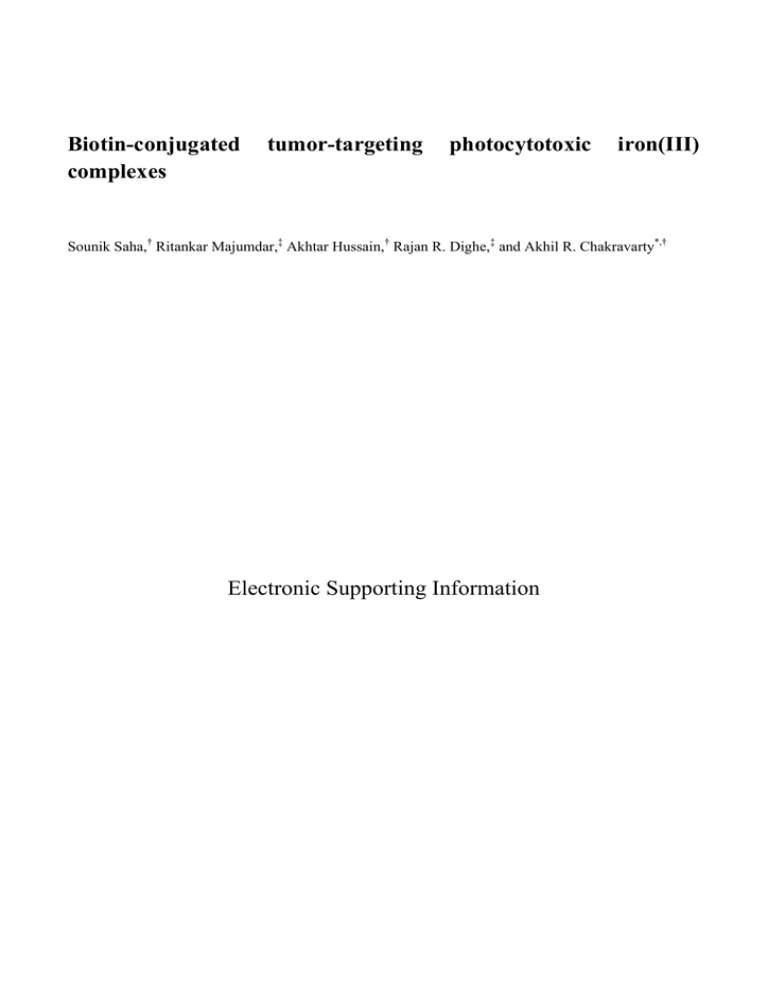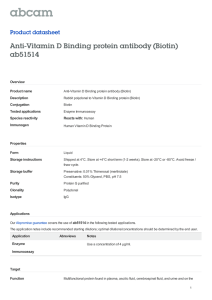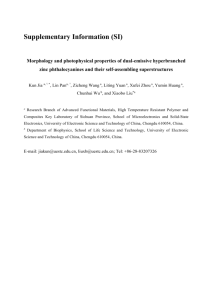Biotin-conjugated tumor-targeting photocytotoxic iron(III) complexes Electronic Supporting Information
advertisement

Biotin-conjugated complexes tumor-targeting photocytotoxic iron(III) Sounik Saha,† Ritankar Majumdar,‡ Akhtar Hussain,† Rajan R. Dighe,‡ and Akhil R. Chakravarty*,† Electronic Supporting Information Synthetic Details Preparation of BFITC. To a solution of biotinylethylenediamine (50 mg, 0.17 mmol) in dimethyl sulfoxide (DMSO, 1.0 mL) was added fluorescein isothiocyanate (FITC, 68 mg, 0.17 mmol) with stirring. The resulting yellow solution was stirred for 36 h at room temperature in dark. The reaction mixture was directly subjected to purification by column chromatography on a silica gel column using (i) ether, (ii) 10% MeOH in CH2Cl2 and (iii) 20% MeOH in CH2Cl2 successively, as eluent to give BFITC (100 mg, 84% yield) as an orange yellow solid. 1H NMR (400 MHz, CD3OD) δ = 1.3-1.64 (m, 6 H), 2.26 (m, 2 H), 2.65 (m, 1 H), 2.90 (dd, 1 H, J = 12 Hz, 4 Hz), 3.20 (m, 1 H), 3.45 (t, 2H, J = 6 Hz), 4.29 (m, 1 H), 4.47 (m, 1 H), 6.57 (m, 2 H), 6.65 (m, 2 H), 6.77 (m, 2 H), 7.14 (m, 1 H, J = 8 Hz), 7.74 (m, 1 H), 8.07 (d, 1 H, J = 4 Hz). Two protons of ethylenediamine linker were not observed possibly due to the presence of MeOH solvent peak at 3.3 ppm. ESI-MS in MeOH: 676.19 (M + H)+. HABA assay To investigate whether the complexes 2 and 4 bind to streptavidin as the same way as free biotin, HABA assay was carried out.48 HABA assay is based on the competition between biotin and HABA on binding to the substrate-binding sites of streptavidin. The binding of HABA to streptavidin is associated with an absorption feature near 500 nm. Since the binding of HABA to streptavidin (Kd = 6 x 10-6 M-1) is much weaker than that of biotin (Kd = 10-15 M-1), addition of biotin replaces the bound HABA molecules, leading to a decrease of the absorbance at 500 nm. Addition of complex 2 or 4 to a mixture of HABA and streptavidin led to a decrease in the absorbance of the spectral band indicating displacement of HABA from the strepavidin molecules. The plots of -ΔA500nm against [compound]:[avidin] for biotin, complexes 2 and 4 showed that the equivalence points occurred at [compound]:[avidin] ratio of 4.0, 4.0 and 3.9 for biotin, 2 and 4, respectively. These results indicate that the binding of the complexes 2 and 4 does retain its streptavidin binding ability similar to biotin and the binding stoichiometry is nearly 4:1. Scheme S1. Synthetic pathway used for the preparation of the ligands (B) and (C). Reagents and conditions: (i) DMF, CDI (excess), en at RT; (ii) dppzc, CDI (3 eq.) in DMF at 80 °C for 16 h; (iii) FITC (1.5 eqv), DMSO, Et3N (excess), 36 h at RT. Scheme S2. Synthetic pathway used for the preparation of the ligand (E). Reagents and conditions: (i) SOCl2, 20 min, RT; (ii) dppza in DMF under N2 at RT for 24 h. Fig. S1. ESI-MS (+ve) spectra of complex 2 in MeOH. Fig. S2. ESI-MS (+ve) spectra of complex 4 in MeOH. Fig. S3. UV-visible spectrum of complex 4 in 6% DMF/Tris HCl buffer. Fig. S4. Cyclic voltammogram of complex 2 in DMF-0.1 M TBAP at a scan rate of 50 mV s-1. Fig. S5. Cyclic voltammogram of complex 4 in DMF-0.1 M TBAP at a scan rate of 50 mV s-1. Fig. S6 UV-visible titration of HABA-streptavidin complex with complex 2 and the inset shows the plot of −ΔA500nm vs. the ratio of compound:streptavidin to determine the binding ratio [square (■) for biotin, circle (●) for 2 and triangle (▲) for 4]. 1.0 0.9 I / I0 0.8 0.7 0.6 0.5 0.4 0.3 2 0 1 2 3 [Fe complex] / mM 4 4 5 Fig. S7. Ethidium bromide displacement assay for determination of the apparent binding constant (Kapp) of the complexes 2 and 4 with ct-DNA in DMF/Tris HCl buffer (pH 7.4). Fig. S8. Thermal denaturation plots to study the effect of the complexes 2, 4 and ethidium bromide on the melting temperature of ct-DNA in DMF/phosphate buffer (pH 6.8). Fig. S9. ESI-MS spectra of dppzNB ligand (a) without Proteinase K treatment and (b) after Proteinase K treatment for 4 h at 37 °C. The site of cleavage is shown above schematically. Fig. S10. ESI-MS spectra of dppzCB ligand (a) without Proteinase K treatment and (b) after Proteinase K treatment for 4 h at 37 °C. Fig. S11. MTT assay showing the effect of dark and light on HepG2 cells treated with different concentrations of [Fe(NO3)3].9H2O for 12 h in dark. (b) Bar diagram showing the effect of light (400700 nm) dose on the cell viability of HepG2 cells as estimated by MTT assay. The esd's correspond to n=3. Table S1. DNA binding parameters for the complexes 2 and 4. Complex ΔTma/ °C Kappb/ M-1 a 2 4 -0.08 -0.15 4.4 x 103 3.7 x 103 Change in melting temperature of CT-DNA. b Apparent DNA binding constant.




